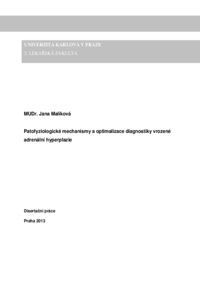Patofyziologické mechanismy a optimalizace diagnostiky vrozené adrenální hyperplazie
Pathophysiological mechanisms and optimization of diagnosing congenital adrenal hyperplasia
dissertation thesis (DEFENDED)

View/
Permanent link
http://hdl.handle.net/20.500.11956/57945Identifiers
Study Information System: 137940
CU Caralogue: 990019128570106986
Collections
- Kvalifikační práce [1804]
Author
Advisor
Consultant
Cinek, Ondřej
Referee
Vrbíková, Jana
Zapletalová, Jiřina
Faculty / Institute
Second Faculty of Medicine
Discipline
Human Physiology and Pathophysiology
Department
Department of Paediatrics
Date of defense
13. 6. 2013
Publisher
Univerzita Karlova, 2. lékařská fakultaLanguage
Czech
Grade
Pass
Autoreferát Souhrn Vrozená adrenální hyperplazie (CAH) je skupinou autozomálnČ recesivních onemocnČní, které jsou charakteristické neadekvátní sekreci steroidních hormonĤ kĤry nadledvin. NejčastČjší se setkáváme s deficitem 21-hydroxylázy (gen CYP21A2), který vede k nedostatečné sekreci mineralokortikoidĤ a glukokortikoidĤ a zároveĖ je pĜítomná nadmČrná produkce androgenĤ. Je patrná dobrá korelaci mezi typem mutace a deficitem 21-hydroxylázy a následnČ klinickým obrazem. Novorozenecký screening CAH (NS CAH) byl zaveden k včasné detekci nejtČžší formy deficitu 21-hydroxylázy (salt wasting formy CAH). NS CAH je založen na mČĜení hladiny 17-OHP ze suché kapky krve pomocí fluoroimunoeseje (Delfia). V ýeské republice byl screening zaveden v roce 2006. Zhodnocením NS CAH za období 2006 - 2011 byla zjištČna senzitivita screeningu 98 %, specificita 99,5 %, nízká pozitivní prediktivní hodnota (PPV) 1,6 % a vysoká četnost falešné pozitivity (FPR) 0,51 % v celé skupinČ vyšetĜených. Díky nízké pozitivní prediktivní hodnotČ screeningu je u části novorozenecké populace (0,51%) hladina 17-OHP opakovanČ kontrolována pro mírné pĜechodné zvýšení 17-OHP nad cut-off limit negativity. K zvýšení pozitivní prediktivní hodnoty mĤže vést jednak úprava cut-off limitĤ a jednak zavedení druhého stupnČ NS. Druhý stupeĖ novorozeneckého...
Autoreferát Summary Congenital adrenal hyperplasia (CAH) is a group of autosomal recessive diseases which are characterized by inadequate secretion of steroid hormones of the adrenal cortex. The most common type of CAH is a deficiency of 21-hydroxylase (CYP21A2 gene), which leads to insufficient secretion of mineralocorticoids and glucocorticoids and excessive androgen production. There is apparent good correlation between the type of mutation and a 21-hydroxylase deficiency, and subsequently the clinical presentation. Neonatal screening for CAH was introduced to early and effectively recognize the most severe type of 21-hydroxylase deficiency (salt wasting form of CAH). Neonatal screening CAH is based on the detection 17-OHP level in dried blood spots by fluoroimmunoassay (Delfia). In the Czech Republic NS CAH was implemented to screening program in 2006. During the period of 2006 - 2011 we evaluated the results of NS CAH and we observed sensitivity of 98%, specificity of 99.5%, a low positive predictive value (PPV) of 1.6% and a high false positive rate (FPR) of 0.51% in the whole group examined newborns. Due to the low positive predictive value in the part of neonatal population (0.51%) the levels of 17-OHP are repeatedly checked for transiently elevated levels of 17-OHP above the cut-off limit of...
